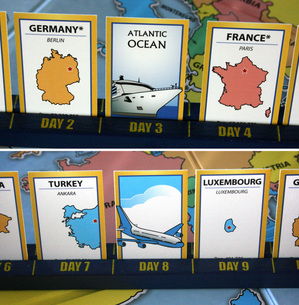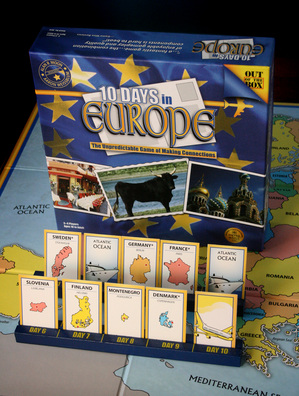10 Days in Europe: A game worth putting on your itinerary
Today's reviewed game, 10 Days in Europe, is a game that, while it doesn’t try to be educational, helped my wife and I figure out where in the world Moldova is. This, primarily, seems to work best as a family game. It works with two to four players and takes about 20 minutes to play.
The game is about moving tiles around in a rack so that you create a 10-day trip itinerary across Europe. If you like Rack-O, this game is similar, yet better.
While this game certainly isn’t going to suit everyone, my wife and I have logged a good number of plays over the past year. Let’s have a look and see if this is the sort of game for you, or if you'll want to send it packing.
Rules:
The board for 10 Days in Europe is really just a reference map for all of the countries on the map: you’ll never be placing any pieces on it. All the action of the game takes place on each player's rack of 10 tiles.
Players start by placing down 10 tiles on their rack, one at a time. The object is to go from this starting point to a rack of 10 tiles where all tiles connect (giving you a 10-day itinerary for your trip).

Mike Hulsebus | Contributor
Tiles are considered connected if:
1. The two countries are adjacent (Sweden, Norway).
2. You connect two countries using an ocean cruise on a body of water they touch.
3. You connect two same-colored cities with a plane of the same color.
On your turn, you draw a tile and discard a tile. When you draw a tile, you can choose to either draw a face-down tile or draw from one of the three piles of discarded face-up tiles. Play continues until someone has connected all 10 of their days into one continuous trip.
Impressions:
The great thing about 10 Days in Europe is you’re free to make your own paths, which is really not as easy at it would seem. I seem to get myself into these predicaments were the first four tiles in my rack connect, and the last four tiles connect, but then I have to figure out if I actually have a chance of finding tiles that will bridge the two or if I would do better to just go from one side of the rack while overwriting the other. There is not a strictly better choice for each tile that you draw
So, yes, despite how it may seem like, there is strategy to this game. You can take risks as to which tiles may show up, and you can also try to discard tiles and hopefully pick them up later.
Beyond that, however, there is certainly plenty of luck to the game. Yes, you start the game and have to plan what tiles you are going to keep and which might become part of your route, but you will also probably spend part of the game saying “Pick up a tile. Does it connect to my route? No. Discard.”
Despite this, when I lose, I still feel like there some reason behind it. It’s not just “Oh, I lost because I never got wild cards” like in Uno, but there is an element of “I should have given up on connecting Norway and just replaced it when I had the chance.”

Mike Hulsebus | Contributor
I don’t want to speak too critically of this game because the main point that I want to get across is that this is a good situational game: There are times when this is the sort of game that my wife and I want to play.
It’s a light game, is quick to set up, and is the right combination of being mindless and having elements of strategy. We typically play three games in a row when we pull out 10 Days in Europe, which is one reason it make it into my top 20 most played games (by hours played) this year.
The one thing that initially seems missing from 10 Days is a scoring system. After a few losses, I started to wish that I earned points for how many countries that I was able to connect. I did end up finding a great scoring system on BoardGameGeek that takes into account how hard different countries are to connect.
However, when we did play using the scoring system, I found it didn’t add as much to the game as I would have thought and now we just play with the rules as printed. This game plays just fine when kept simple.
If you are looking for a game to break out with your gamer friends, this isn’t it. This also isn’t a game that I would reach for when having another couple over. For us, this is a good two-player game that works well because it’s quick and fun. If you like Rack-O or certain elements of rummy, this could be your kind of game. To me, this feels like a good family game that ought to be in traditional department store board game sections.
Grades of those I have played with:
Karen: B+ Fun
My mom: B It seemed like it was part strategy and part luck, and like you always had a chance to win. It didn't look like a game I would enjoy, but once I played it, I liked it.
Me: B- I would have given it a C+ but I gave it extra credit for filling an important role in my game collection.
Jake: C+ Not a horrible game, but not very exciting either.
Mike Hulsebus invites you to scroll up and notice how much Germany looks like a face with an open mouth. Tell him that not you can't un-see it by emailing him at mikehulsebus@gmail.com.

